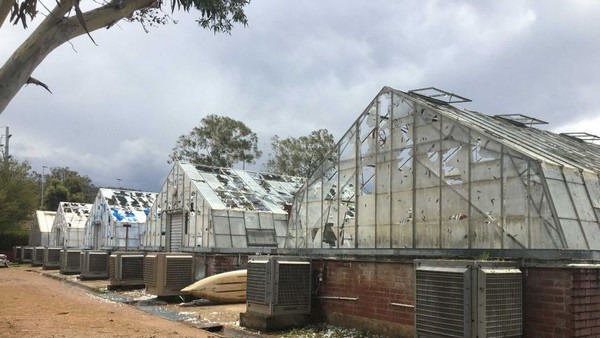Critical research to prepare Australia's crops for harsher weather has been kept on hold after a devastating hailstorm that swept through Canberra damaged Australian National University glasshouses 12 months ago.
It is now a distant memory thanks to the dominating presence of the coronavirus pandemic, but this time last year, international attention turned to the 65 glasshouses destroyed by hailstones as big as golf balls at the ANU and CSIRO sites. Inside was years of valuable crop sustainability research.
A year on, the glasshouses look much the same — with just one repaired in the past year — as researchers continue to wait for an insurance claim to be processed.
"It is frustrating — several of us did not even want to do an interview because it is so depressing to walk onto this campus and see these empty spaces," plant biology professor Barry Pogson said. "We used funds from the faculty of science and our school to repair one of them, so some of our projects are ticking over."

Limited research
Important milestones are being missed, compromising future plans, and risking funding from organisations such as the Bill and Melinda Gates Foundation. Researchers fear Australia's food security will be more limited as a consequence.
In the wake of the storm, the plan had been to rebuild the precinct and future-proof the research — but the pandemic put a stop to that plan before it could get underway. "COVID happened, budgets got smashed and we went back to a plan of getting insurance funds to replace damaged panels, and we have been stuck waiting for insurance funds to be released," Professor Pogson said.
Timeline to restart research recedes further into distance
It is hard to put a figure on the exact financial cost of the hailstorm on the ANU's research, but it is estimated to be in the tens of millions. And researchers say the COVID-19 pandemic has further slowed what was already set to be a long recovery.
Insurance
Ulrike Mathesius says research will take months to restart even after the insurance claim is processed.(ABC News: Ian Cutmore)
Even if the insurance claim for the damaged buildings is successful and funds are released, it will take a while to rebuild what was damaged — let alone start up research projects again.
"It is frustrating for researchers because we do not know when it is going to happen," plant microbiologist Ulrike Mathesius said. "Once it happens, there will still be quite a few months until things can get shipped here and glasshouses can be rebuilt to their old standard.
"That is just to take us where we were a year ago, the plan was to make this a much more accessible place to the public and all those hopes have been dashed because of the compounding effect of the COVID crisis".
Several research projects were compromised or outright destroyed in the storm, wiping out years of work for researchers. Professor of ecology and evolution Adrienne Nicotra was one those most affected. "We had a four-year experiment looking at the effects of changing climate on alpine native plant species and it was three months away from completion when the hailstorm came," Professor Nicotra said.
She lost more than three years of research, but at the time was optimistic the repair would be quick enough to allow them to finish the experiment. "Without the facilities, we have had to dramatically scale back and really change our ambitions," she said.
Other research compromised included an international food security project focusing on improving rice yield, and a project to help secure our own food supply.
"A large body of research that was lost was to try and improve crop plants to make sure that crops can grow in more extreme environments," Professor Mathesius said. "Our crop production in Australia is going to be limited much more by ongoing climate change and more extreme weather events — just like the hailstorm."
The greenhouses at CSIRO were severely damaged by hail that swept through Canberra. (ABC News: Jordan Hayne)
An additional problem for researchers is that much of their funding is dependent on international foundations, like the Bill and Melinda Gates Foundation.
But for many of those partnerships to continue, research milestones need to be hit. Caitlin Byrt, a group leader at the ANU's School of Biology, also lost a huge number of research crops as a result of the hailstorm. "We have lost a year of time in terms of the experiments and we have also had to scale down the numbers of plants and the size of the experiments that we can actually manage," Dr Byrt said.
"Our ability to build back up momentum and reach the kind of capability we want depends entirely on our opportunity to redevelop and build this site."

The Australian National University
Canberra ACT 2600 Australia
www.anu.edu.au
